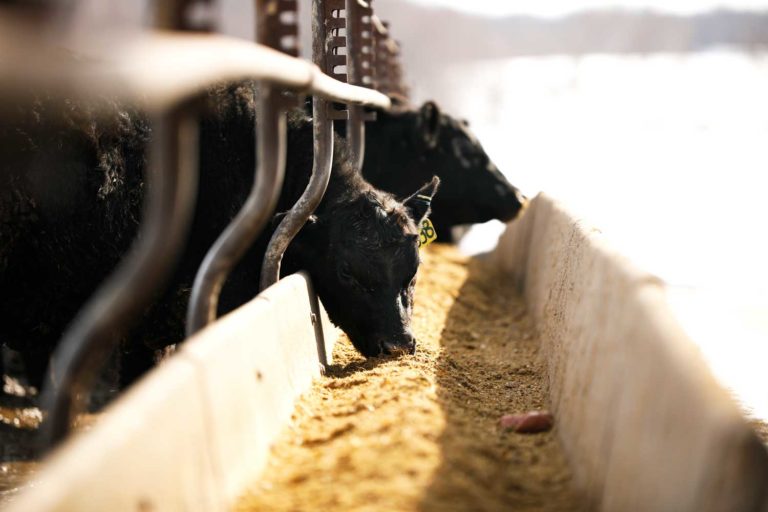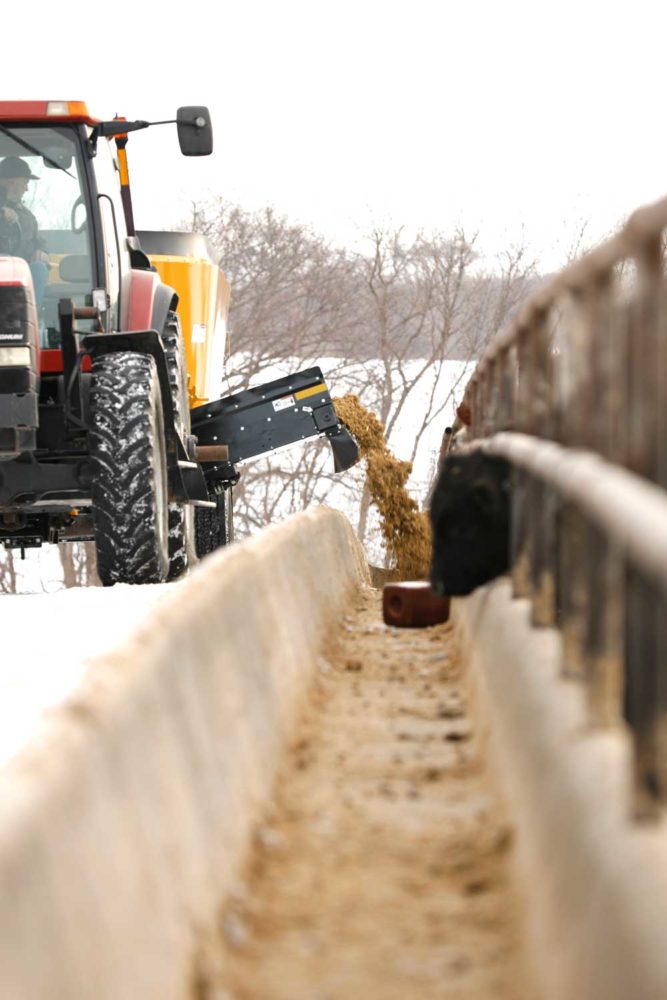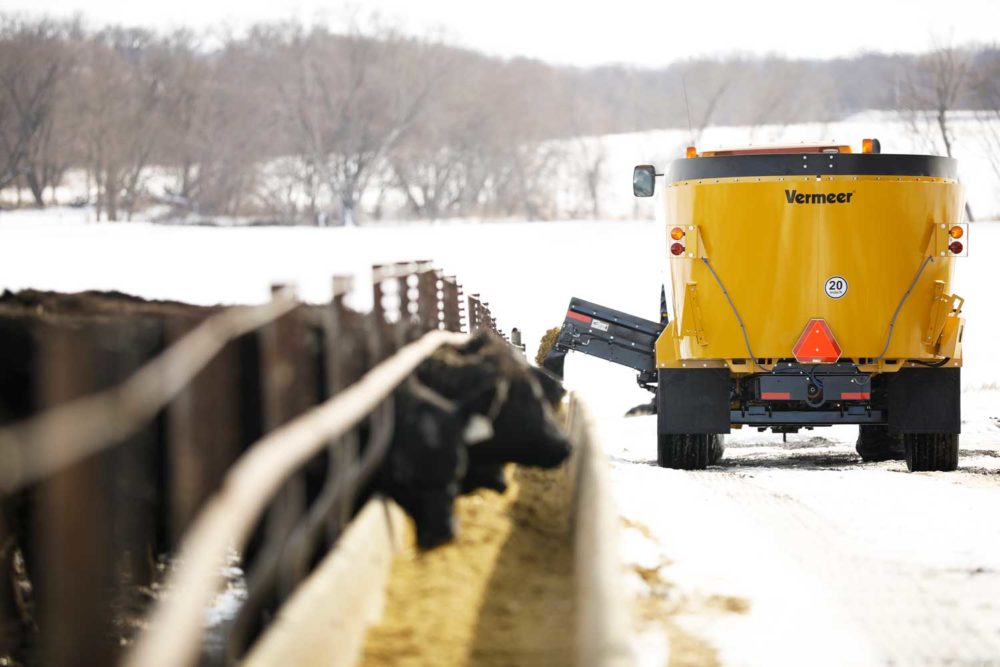
Help prevent costly forage waste, optimize feeding with a vertical feed mixer
March 2021
Profit margins are usually tight for cattle producers. They’re even tighter if you’re not maximizing your herd’s time at the bunk with maximum nutrition and minimal feed waste. A combination of attention to your cattle feed ingredients and how you’re distributing them to your herd can make a major difference in overall feed costs, which is typically the greatest expense for most cattle producers. A vertical feed mixer may be part of the feed cost equation for your operation.
If you’re free-choice feeding, you’re wasting feed.
Unrolling a large round bale or dropping it in a ring feeder and letting cattle feed freely are a couple of the lowest-cost and lowest-labor strategies to deliver forage to cattle in a pasture, hoop building or corral setting, but they also offer the least control. Cattle can drop, trample and generally waste hay when eating in this manner. Not to mention, when an animal consumes more than it needs, it typically gains extra fat or excretes it without absorbing the nutrients — causing the value of the forage to decline. When you’re free-choice feeding, a lot of hay can go to waste, even if you are only feeding hay for part of the year.
Feeding data shows up to 9 pounds (4.1 kg) of feed is wasted per animal each day when free feeding. That cost can add up quickly, even when feeding part of the year and grazing during the spring and summer, according to Purina Nutritionist Tyler Long.

Applying those types of losses across the investment required to finance an entire operation, and the revenue erosion is crystal clear.
“If you take $5,000 per acre of land on a 30-year note at 4.5% interest, you’re paying $310 per acre for that land per year. If that acre of ground is costing you $310 per year and half of it is idle, in a 100-cow scenario, that’s around $10,000 just out the window,” Long said. “It’s not my job to poke holes in a producer’s operation, but when it comes down to these types of numbers, I sure think we need to bring some of these issues to light to show them these are pretty real numbers.”
Transitioning from free-choice feeding to an optimized total mixed ration or a complete ration with a vertical feed mixer can create quick, immediately measurable improvements. Long said making a change from lower-quality brome hay to a higher-quality forage, for example, can meet the daily protein and energy needs of a 1,500-pound lactating cow while feeding 8 pounds (3.6 kg) fewer per day. From a cost perspective, the savings adds up; a total mixed ration comprising ground dry hay, silage and rye, for example, costs around $0.13 per day per head less than a straight ground hay ration, Long said. While that savings alone adds up, this type of optimized ration in a controlled-feeding system helps keep animal weight and body composition where it needs to be on a cost-efficient basis and with minimal waste.

Start taking control of your feeding strategies.
Taking control of your feeding strategies can limit this waste. It can help make better use of every acre of production and bale you feed as a component of a productive ration that includes not only high-quality forage, but the right balance of grain, protein, vitamins and minerals. That process starts by getting a firm grasp on the nutritional needs of your animals, your forage resources and how far they’ll go in sustaining your herd. A gestating cow, for example, has much greater nutritional needs than an open cow. Talk to your nutritionist if you have questions about your specific herd’s nutritional needs. See a full rundown of how nutritional needs vary between different beef animals here.
Once you know the quality and quantity of forage you need to produce to yield the right feed ration for your cattle, it’s time to examine your feeding practices and equipment to ensure you’re minimizing waste. One component of delivering an optimal total mixed ration — a process that today often involves a nutritionist on many operations — is using equipment that processes, prepares and delivers the right mixture of roughage, protein and energy without increasing labor requirements.
A Vermeer vertical feed mixer is one of those tools. With multiple sizes available, the Vermeer lineup of vertical feed mixers gives operators the option to mix all ration ingredients like dry hay, silage, grain and ethanol co-products at once. The result is a consistently mixed ration every time the operator feeds cattle.
Here’s how a vertical feed mixer makes quick work.

“A total mixed ration type of feeding approach can certainly help protect and improve herd health. The mineral and some of those types of additives are added in pretty small dosages per head per day. That’s where a feed mixer that mixes reliably is really required — when you’re adding high-powered performance additives,” according to Vermeer Territory Sales Manager Jordan Schuler. “A mixer with a scale can be an important piece of the puzzle in feeding the right ration to manage that feed cost.”
“A lot depends on size and type of operation. In the Midwest and eastern U.S., for example, there are some cow-calf operations and backgrounders who don’t feed a complete ration, so a vertical feed mixer isn’t necessarily needed, and a bale processor may be a better option,” Schuler said. “But if your ration includes ethanol co-products, silage and other feedstuffs that are common today, a mixer becomes a necessity, so those feedstuff ingredients are used efficiently. For a lot of larger feeders, a complete ration is pretty much a way of life just like it is for most dairy operations. Depending on what you feed, as well as how and where you feed, it’s worth it to consider a feed mixer.”
Choosing the right feed mixer for your operation is another component of a cost-efficient total mix ration management strategy. With multiple models of vertical feed mixers available, Vermeer has machines to fit a wide array of operation sizes. Consider the overall size of your operation, your existing equipment and the types of rations you’re handling in determining which one is right for you. For example, Vermeer vertical feed mixers feature loading heights ranging from 106 inches to 155 inches (269 cm to 394 cm) and operating capacities between 350 cubic feet and 1,690 cubic feet (9.9 m3 and 47.9 m3), all of which could influence which model will best fit your operation.
“Whether you’re feeding gestating cows or backgrounding calves, knowing your head count, feedstuffs at your disposal, nutritionist’s recommendations and how often you feed will help you come up with the cubic feet of feed per day that you will be handling,” Schuler said. “That will help your Vermeer dealer size the right capacity machine for you. It will be immensely helpful in choosing the right feed mixer.”
Contact your local Vermeer dealer to start working toward adding a vertical feed mixer to your operation.
